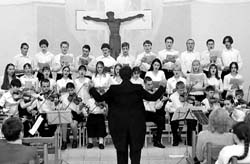Children’s View Of Grownup Music

St. Catherine’s Lutheran Cathedral hosted a concert by Dmytro Hershkovych’s Children’s Symphony Orchestra and Choir, summing up the company’s performances for the year and ending the 2001-02 season.
Sired by the maestro’s lofty dedication and boundless enthusiasm, it will soon mark its tenth anniversary. Mr. Hershkovych admits that he actually picked a number of musicians off the street and that not all of his children could read music. He sees the company’s main purpose in propagating classical music; the young performers are expected to prove that its correct perception and rendition is within the reach of both adults and children. Pre-romantic music is known for its clarity and is thus particularly close to young performers; it is ingenuous and very emotional.
The company is formally known as a children’s symphony orchestra and choir. It is composed of about fifty children and young people, half of them make up the choir and the other half the symphony orchestra. At that particular concert the latter was represented by the string group complimented by two trumpets from the Opera. A number of renditions were accompanied by the organ, with an adult musician at the keyboards. Now and then the orchestra is reinforced by wood wind instruments and French horns. By all appearances, the children’s symphony orchestra is content with having just the above-mentioned string group.
The concert included passages from Handel’s oratorios, The Messiah and Judas Maccabeus; Mozart; and Bach. Such masterpieces of religious music are very difficult to perform even for adult musicians with the sophisticated choral fugue from Judas Maccabeus and Mozart’s Lacrymosa. The latter requires a very special approach and is not often included even in professional concert programs. Performed by children, these works sounded in a very special way, with the trumpet now and then rising over the joyous cacophony, showing the trumpeter’s high professional level. As a result, this contrast served further to emphasize the amateurish nature of the company. The approach to the repertoire could be compared to an episode from the performing biography of this author who, while in the sixth year of a children’s music school, attempted a conservatory piano program. In both cases the result was the same: much emotion and very little music.
The choir was more or less all right. The children obviously enjoyed singing and at times there was some resemblance to an ensemble. With the orchestra the situation was worse. It takes years, even decades to master a string instrument to a passable degree. In this case the performers were music school students, not all of them senior graders. In addition, the children did not know how to play in an orchestra. It was only toward the end of the concert that they had achieved a degree of orchestration, so that works performed at the beginning and then encored sounded better the second time around.
Thus the young musicians showed not so much their professional skill as their ability to be fond of serious music rather than all that cheap pop along with their readiness to share their dedication with others, revealing the emotional aspect of the music. Dmytro Hershkovych says that he is not the company’s principal motive force, but his pupils. Despite all shortcomings, most likely caused by adolescent enthusiasm, their devotion to classical music can only be marveled. Hopefully, the company will score a number of creative successes and appear in concerts to full houses.






